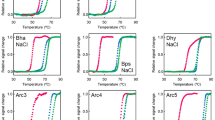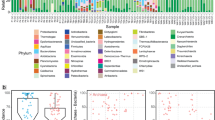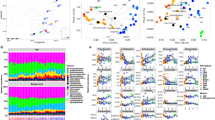Abstract
Extensive genomic characterization of multi-species acid mine drainage microbial consortia combined with laboratory cultivation has enabled the application of quantitative proteomic analyses at the community level. In this study, quantitative proteomic comparisons were used to functionally characterize laboratory-cultivated acidophilic communities sustained in pH 1.45 or 0.85 conditions. The distributions of all proteins identified for individual organisms indicated biases for either high or low pH, and suggests pH-specific niche partitioning for low abundance bacteria and archaea. Although the proteome of the dominant bacterium, Leptospirillum group II, was largely unaffected by pH treatments, analysis of functional categories indicated proteins involved in amino acid and nucleotide metabolism, as well as cell membrane/envelope biogenesis were overrepresented at high pH. Comparison of specific protein abundances indicates higher pH conditions favor Leptospirillum group III, whereas low pH conditions promote the growth of certain archaea. Thus, quantitative proteomic comparisons revealed distinct differences in community composition and metabolic function of individual organisms during different pH treatments. Proteomic analysis revealed other aspects of community function. Different numbers of phage proteins were identified across biological replicates, indicating stochastic spatial heterogeneity of phage outbreaks. Additionally, proteomic data were used to identify a previously unknown genotypic variant of Leptospirillum group II, an indication of selection for a specific Leptospirillum group II population in laboratory communities. Our results confirm the importance of pH and related geochemical factors in fine-tuning acidophilic microbial community structure and function at the species and strain level, and demonstrate the broad utility of proteomics in laboratory community studies.
Similar content being viewed by others
Log in or create a free account to read this content
Gain free access to this article, as well as selected content from this journal and more on nature.com
or
References
Amann RI . (1995). Fluorescently labelled, rRNA-targeted oligonucleotide probes in the study of microbial ecology. Mol Ecol 4: 543–554.
Andersson AF, Banfield JF . (2008). Virus population dynamics and acquired virus resistance in natural microbial communities. Science 320: 1047–1050.
Belnap CP, Pan C, VerBerkmoes NC, Power ME, Samatova NF, Carver RL et al. (2010). Cultivation and quantitative proteomic analyses of acidophilic microbial communities. ISME J 4: 520–530.
Bond PL, Banfield JF . (2001). Design and performance of rRNA targeted oligonucleotide probes for in situ detection and phylogenetic identification of microorganisms inhabiting acid mine drainage environments. Microb Ecol 2: 149–161.
Bond PL, Druschel GK, Banfield JF . (2000a). Comparison of acid mine drainage microbial communities in physically and geochemically distinct ecosystems. Appl Environ Microbiol 66: 4962–4971.
Bond PL, Smriga SP, Banfield JF . (2000b). Phylogeny of microorganisms populating a thick, subaerial, predominantly lithotrophic biofilm at an extreme acid mine drainage site. Appl Environ Microbiol 66: 3842–3849.
Breitbart M, Wegley L, Leeds S, Schoenfeld T, Rohwer F . (2004). Phage community dynamics in hot springs. Appl Environ Microbiol 70: 1633–1640.
Danovaro R, Dell’Anno A, Corinaldesi C, Magagnini M, Noble R, Tamburini C et al. (2008). Major viral impact on the functioning of benthic deep-sea ecosystems. Nature 454: 1084–1087.
Denef VJ, Kalnejais LH, Mueller RS, Wilmes P, Baker BJ, Thomas BC et al. (2010a). Proteogenomic basis for ecological divergence of closely related bacteria in natural acidophilic microbial communities. Proc Natl Acad Sci 107: 2383–2390.
Denef VJ, Mueller RS, Banfield JF . (2010b). AMD biofilms: using model communities to study microbial evolution and ecological complexity in nature. ISME J 4: 599–610.
Denef VJ, VerBerkmoes NC, Shah MB, Abraham P, Lefsrud M, Hettich RL et al. (2009). Proteomics-inferred genome typing (PIGT) demonstrates inter-population recombination as a strategy for environmental adaptation. Environ Microbiol 11: 313–325.
Druschel G, Baker B, Gihring T, Banfield J . (2004). Acid mine drainage biogeochemistry at Iron Mountain, California. Geochemical Trans 5: 13.
Edwards KJ, Bond PL, Gihring TM, Banfield JF . (2000). An archaeal iron-oxidizing extreme acidophile important in acid mine drainage. Science 287: 1796–1799.
Edwards KJ, Gihring TM, Banfield JF . (1999). Seasonal variations in microbial populations and environmental conditions in an extreme acid mine drainage environment. Appl Environ Microbiol 65: 3627–3632.
Eng JK, McCormack AL, Yates III JR . (1994). An approach to correlate tandem mass spectral data of peptides with amino acid sequences in a protein database. J Am Soc Mass Spectrom 5: 976–989.
Eppley JM, Tyson GW, Getz WM, Banfield JF . (2007). Genetic exchange across a species boundary in the archaeal genus Ferroplasma. Genetics 177: 407–416.
Green JL, Bohannan BJM, Whitaker RJ . (2008). Microbial Biogeography: From Taxonomy to Traits. Science 320: 1039–1043.
Hunt DE, David LA, Gevers D, Preheim SP, Alm EJ, Polz MF . (2008). Resource partitioning and sympatric differentiation among closely related bacterioplankton. Science 320: 1081–1085.
Jeans C, Singer SW, Chan CS, VerBerkmoes NC, Shah M, Hettich RL et al. (2008). Cytochrome 572 is a conspicuous membrane protein with iron oxidation activity purified directly from a natural acidophilic microbial community. ISME J 2: 542–550.
Jessup CM, Kassen R, Forde SE, Kerr B, Buckling A, Rainey PB et al. (2004). Big questions, small worlds: microbial model systems in ecology. Trends in Ecology & Evolution 19: 189–197.
Johnson DB . (1998). Biodiversity and ecology of acidophilic microorganisms. FEMS Microbiology Ecology 27: 307–317.
Kaeberlein T, Lewis K, Epstein SS . (2002). Isolating ‘uncultivable’ microorganisms in pure culture in a simulated natural environment. Science 296: 1127–1129.
Kassen R, Rainey PB . (2004). The ecology and genetics of microbial diversity. Ann Rev Microbiol 58: 207.
Lo I, Denef VJ, VerBerkmoes NC, Shah MB, Goltsman D, DiBartolo G et al. (2007). Strain-resolved community proteomics reveals recombining genomes of acidophilic bacteria. Nature 446: 537–541.
Louis P, Galinski EA . (1997). Characterization of genes for the biosynthesis of the compatible solute ectoine from Marinococcus halophilus and osmoregulated expression in Escherichia coli. Microbiology 143: 1141–1149.
Macalady JL, Vestling MM, Baumler D, Boekelheide N, Kaspar CW, Banfield JF . (2004). Tetraether-linked membrane monolayers in Ferroplasma spp: a key to survival in acid. Extremophiles 8: 1433–4909.
Martiny JBH, Bohannan BJM, Brown JH, Colwell RK, Fuhrman JA, Green JL et al. (2006). Microbial biogeography: putting microorganisms on the map. Nat Rev Micro 4: 102–112.
Pan C, Kora G, McDonald WH, Tabb DL, VerBerkmoes NC, Hurst GB et al. (2006a). ProRata: A quantitative proteomics program for accurate protein abundance ratio estimation with confidence interval evaluation. Anal Chem 78: 7121–7131.
Pan C, Kora G, Tabb DL, Pelletier DA, McDonald WH, Hurst GB et al. (2006b). Robust estimation of peptide abundance ratios and rigorous scoring of their variability and bias in quantitative shotgun proteomics. Anal Chem 78: 7110–7120.
Prosser JI, Bohannan BJM, Curtis TP, Ellis RJ, Firestone MK, Freckleton RP et al. (2007). The role of ecological theory in microbial ecology. Nat Rev Micro 5: 384–392.
Ram RJ, VerBerkmoes NC, Thelen MP, Tyson GW, Baker BJ, Blake II RC et al. (2005). Community proteomics of a natural microbial biofilm. Science 308: 1915–1920.
Rocap G, Larimer FW, Lamerdin J, Malfatti S, Chain P, Ahlgren NA et al. (2003). Genome divergence in two Prochlorococcus ecotypes reflects oceanic niche differentiation. Nature 424: 1042–1047.
Rodriguez-Valera F, Martin-Cuadrado A-B, Rodriguez-Brito B, Pasic L, Thingstad TF, Rohwer F et al. (2009). Explaining microbial population genomics through phage predation. Nat Rev Micro 7: 828–836.
Simmons SL, DiBartolo G, Denef VJ, Goltsman DSA, Thelen MP, Banfield JF . (2008). Population genomic analysis of strain variation in Leptospirillum Group II bacteria involved in acid mine drainage formation. PLoS Biology 6: e177.
Tabb DL, McDonald WH, Yates III JR . (2002). DTASelect and Contrast: Tools for assembling and comparing protein identifications from shotgun proteomics. J Proteome Res 1: 21–26.
Thompson JR, Pacocha S, Pharino C, Klepac-Ceraj V, Hunt DE, Benoit J et al. (2005). Genotypic diversity within a natural coastal bacterioplankton population. Science 307: 1311–1313.
Tyson GW, Chapman J, Hugenholtz P, Allen EE, Ram RJ, Richardson PM et al. (2004). Community structure and metabolism through reconstruction of microbial genomes from the environment. Nature 428: 37–43.
Tyson GW, Lo I, Baker BJ, Allen EE, Hugenholtz P, Banfield JF . (2005). Genome-directed isolation of the key nitrogen fixer Leptospirillum ferrodiazotrophum sp. nov. from an acidophilic microbial community. Appl Environ Microbiol 71: 6319–6324.
Wilmes P, Andersson AF, Lefsrud MG, Wexler M, Shah M, Zhang B et al. (2008a). Community proteogenomics highlights microbial strain-variant protein expression within activated sludge performing enhanced biological phosphorus removal. ISME J 2: 853–864.
Wilmes P, Remis JP, Hwang M, Auer M, Thelen MP, Banfield JF . (2008b). Natural acidophilic biofilm communities reflect distinct organismal and functional organization. ISME J 3: 266–270.
Acknowledgements
Mr Ted Arman (President, Iron Mountain Mines) and Dr Richard Sugarek are thanked for site access and other assistance. Dr Paul Wilmes and Dr Ryan Mueller are thanked for helpful discussions. This research was supported by the US Department of Energy, Office of Biological and Environmental Research through the Genomic Science Program (contract numbers DE-FG02-05ER64134, DE-SC0004665 and DE-SC0004918), Office of Advanced Scientific Computing Research through the SciDAC Program, the NSF Biocomplexity Program and the NASA Astrobiology Institute.
Author information
Authors and Affiliations
Corresponding author
Additional information
Supplementary Information accompanies the paper on The ISME Journal website
Rights and permissions
About this article
Cite this article
Belnap, C., Pan, C., Denef, V. et al. Quantitative proteomic analyses of the response of acidophilic microbial communities to different pH conditions. ISME J 5, 1152–1161 (2011). https://doi.org/10.1038/ismej.2010.200
Received:
Revised:
Accepted:
Published:
Issue date:
DOI: https://doi.org/10.1038/ismej.2010.200
Keywords
This article is cited by
-
Proteomic characterization of metal recovery process realized by marine bacteria bacillus subtilis Hyhel1expossed to bioleaching liquor
Brazilian Journal of Chemical Engineering (2023)
-
Heavy thinning temporally reduced soil carbon storage by intensifying soil microbial phosphorus limitation
Plant and Soil (2023)
-
Microbial diversity in extreme environments
Nature Reviews Microbiology (2022)
-
Biofilm as an adaptation strategy to extreme conditions
Rendiconti Lincei. Scienze Fisiche e Naturali (2022)
-
Recent progress in the application of omics technologies in the study of bio-mining microorganisms from extreme environments
Microbial Cell Factories (2021)



